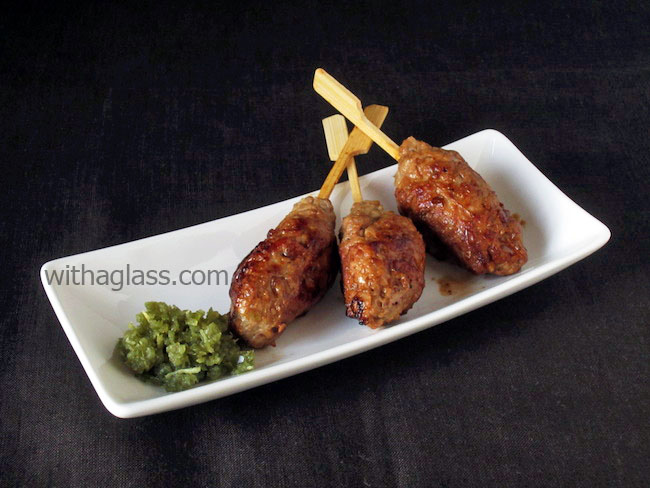Duck Tsukune (Japanese Ground Duck Skewers)
 Tsukune, or ground meat skewers, are the first thing I order whenever I go to an izakaya, a Japanese pub (the probability they serve it is very high). As I have mentioned here, in a place specialised in yakitori (chicken skewers), tsukune’s taste measures the cook’s skills and the place’s ambitions, so if they are just average, it’s probably high time to move to a different pub… A huge majority of tsukune are prepared with chicken meat, so using another bird instead is not a revolutionary idea, but this slight modification does make a nice change and I see this stronger-flavoured version as cold-season tsukune. I found the green chilli and lime zest paste (raimu koshou, my Westernised version of yuzu koshou) an extraordinary flavours enhancer here.
Tsukune, or ground meat skewers, are the first thing I order whenever I go to an izakaya, a Japanese pub (the probability they serve it is very high). As I have mentioned here, in a place specialised in yakitori (chicken skewers), tsukune’s taste measures the cook’s skills and the place’s ambitions, so if they are just average, it’s probably high time to move to a different pub… A huge majority of tsukune are prepared with chicken meat, so using another bird instead is not a revolutionary idea, but this slight modification does make a nice change and I see this stronger-flavoured version as cold-season tsukune. I found the green chilli and lime zest paste (raimu koshou, my Westernised version of yuzu koshou) an extraordinary flavours enhancer here.
If it’s the first time you come across this name, “tsukune (捏ね or つくね)” apparently comes from the verb “tsukuneru” (to knead) and refers to the fact that the patties shaping process involves more or less kneading. Even though they are usually made with chicken, other meats can also be used or a mixture of meats. The shape also varies: while most yakitori-serving restaurants give them an oval shape and grill them on skewers, tsukune can also be round and pan-fried or simmered in soups.
This recipe is loosely based on the Chicken Tsukune posted here, which was based on a recipe from Izakaya: the Japanese Pub Cookbook by Mark Robinson, a fabulous cookbook and Tokyo izakaya guide in one. As I have mentioned above, I served these tsukune with raimu koshou and its mixture of hot and slightly bitter flavours was the best seasoning I can imagine.
If you don’t have or like duck meat, you might want to try the basic, chicken tsukune version:

TIPS : For optimal results do not use ground duck breast here (you can use it as a small part of the meat mixture), otherwise the tsukune will be tough and dry.
If you cannot find ground duck legs, you can easily mix them in a food processor (this is what I did). After grinding, remove any long stringy white bits you see (unless you have a real meat grinder; then the result should be perfect). You can grind the meat almost to a pulp, if you wish, but I liked the slightly chunky texture too.
I prefer my teriyaki glaze less sweet than the one usually served in Japanese restaurants, but feel free to add more mirin or sugar if you prefer it sweeter.
Raimu koshou (lime zest and chilli paste) recipe is very easy and goes perfectly with strong flavoured meat dishes or ramen soups:

If you don’t have time to make the lime and chilli paste properly (it does take several days to mature), you can try a quick version, mixing the chilli and the zest with salt just before serving the tsukune.
Special equipment: skewers (I have used 8) and a brush
Preparation: about one hour
Ingredients (serves two as a snack):
ground meat from 2 medium duck legs (about 250 – 300 g/9 – 10 oz)
1 small onion (I have used a shallot)
(optionally: grated zest from one big lemon or 2 limes)
salt, pepper
oil
Teriyaki glaze:
3 tablespoons soy sauce
1 tablespoon sake
1 tablespoon mirin (sweet cooking sake)
Chop the onion and combine with the zest, the salt and the pepper.
Refrigerate for one hour (you can skip this step if you are in a hurry, but it lets the flavours mix better together).
15 minutes before grilling or pan-frying, soak the skewers (if you use wooden ones) in water.
Form equal balls in your palms, slightly kneading the meat.
Give the balls an oval shape and “stick” them around the skewers, pressing with your palm, making sure they don’t fall off the skewer (I was worried they would fall, but mine never did).
Heat the glaze ingredients in a pan until it thickens.
Put aside.
Grill the skewers on a grill or on a pan, turning them regularly.
If you grill them on a pan, I advise keeping the pan covered, so that you don’t end up with raw meat inside and burnt outside. I turned them four times (as if they had four sides), each time after about a minute.
Just before serving, warm the teriyaki glaze a bit and brush the skewers with it.
I’ve yet to try chicken tsukune and this duck version just makes me think that I’m missing out on a great dish. I wish it were bbq season though as pan frying isn’t as appealing. I’d love to get that smoky tasty you get on a grill. I wonder if you could use a combination of duck and turkey leg meat to extend the amount of meat if serving a larger group.
Thank you, A_Boleyn. Of course you can “extend” the meat with whatever you want, but then I think it wouldn’t have much duck taste. In this case, try making it simply with turkey.
That makes a lot of sense. Thank you. 🙂
I remember your ground chicken skewers with lemon Sissi and my amazement in discovering that they were not singular fillets – such a great result. I’ve yet to try the experiment but with the holidays coming right up, this is a great reminder to do so! My husband travels to Japan frequently — I’ll have to put the bug in his ear about ordering tsukune ;-).
Thank you so much, Kelly. They somehow start sticking together quite quickly, but they are far from being smooth and neat! Tell your husband to ask for it in any izakaya. Most izakayas (even those which serve different kinds of food, not only skewers) make tsukune too.
They do look incredibly tasty Sissi and I bet the citrus zest adds an incredible freshness to this very nice finger food. Each culture has something very similar, don’t they. I’ve not tried the Japanese version but I have made Indian Koftas as well as the Greek Kebabs. Coincidentally, I have those very same skewers!
Thank you so much, Eva. Ground meat is the cheapest meat option and yet, such wonderful and delicious things can be made with it! No wonder every culture has something special made with it. What a coincidence! I like these skewers a lot. They are easy to turn on the pan.
Those ground meat sure look very flavorful but I am worried that it would fall apart if I make it. They must be packed really tight to the skewers in order for them to bind. They look delicious, Sissi. 🙂
Thanks a lot, Ray. You are very kind, but I’m sure you would find it ridiculously easy to prepare. Somehow, miraculously, they stick to the skewers! No effort here.
I think I have already told you how much I like chicken tsukune. Your duck tsukune must taste a lot better!
Thank you, Hiroyuki. We are both big fans of tsukune, but my tsukune are far worse than the good ones in Japan… My favourite tsukune were made with ground cartilage, but I have never tested it at home… Time to try one day.
Sissi, This looks wonderful! Really, really good! I have never thought about making tsukune with duck meat but sounds so interesting. You’re so creative and an amazing cook!
Thank you so much, Nipponnin. Duck is a nice change, though I still prefer chicken ones to be frank.
Oh how I love duck! It’s extremely expensive here, but what a wonderful thing to splurge on. I do have a place where I can get duck legs and this is a great recipe to try over the holidays. You always turn me on to the greatest challenges! Can definitely see how your chilli and lime paste would be a fabulous complement. Great plate of food Sissi!
Thank you so much, MJ. Here ducks are also more expensive than chicken, but strangely in my organic shop chicken and duck legs have a similar price… If I were you I’d rather make duck confit (“confit de canard”) since the meat is very expensive in your area. It’s a pity to spoil it on tsukune which are fantastic with humble chicken too!
These skewers look so good Sissi, although I do not often use duck, I am sure that chicken will taste as good as well…sound delicious with the chili and lime zest sauce…
Thanks for another fantastic recipe…hope you are having a great week 🙂
Thank you, Juliana. Duck is certainly a nice change, but I couldn’t say it tastes better than chicken. Chicken tsukune are fantastic indeed.
Very interesting, I’ve never tried duck “kebab”. Nor a duck burger. In Kyrgyzstan duck is cheaper than chicken – you’ve inspired me.
Thank you, Mr. Three-Cookies. You should profit from this unusual situation!
Duck is really hard to find here except Christmas. But I think chicken will work just fine with these as well! Delicious as always Sissi!
Thank you, Katerina. Chicken is delicious here, no need to look for duck meat of course.